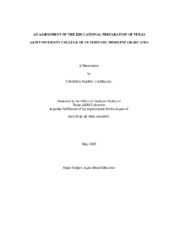| dc.description.abstract | The purpose of this study was to determine the initial and actual professional
goals, the changes in initial and actual professional goals and the reasons for this change
of the different Texas A&M University veterinary medicine graduates from 1990-2002,
how satisfied the selected veterinary medicine graduates were with their veterinary
medicine college educational preparation from the graduating classes representing
1990-2002, and to determine if the top ranked courses have changed among the
veterinary medicine graduates from 1990 until 2002.
The descriptive research design included a questionnaire that was provided to
Texas A&M UniversityÂ’s College of Veterinary Medicine graduates one year following
graduation. Data was collected from the group of veterinarians who graduated during
1990-2002.
Findings indicate that since 1990, veterinary students have entered the College
of Veterinary Medicine with a predominant interest in small animal or mixed practices.
This study shows the stability of the career choices with mixed and small being
consistently the first and second choices over the span of years studied. No apparent trend appeared from the data that identifies one compelling reason
for changing jobs. The overall satisfaction for the educational preparation on their
education is 90% or more. The top-ranked basic science courses have not changed
among the veterinary medicine graduates during the selected period and these are:
“Pharmacology,” “Gross Anatomy,” “Endocrine,” “Parasitology,” “Physiology” and
“Clinical Pathology.” The top-ranked clinical disciplines are not as clearly ranked as the
basic sciences. They are: “Anesthesiology,” “Gastroenterology,” “General Surgery,”
“Internal Medicine,” “Oncology,” and “Radiology.” No apparent trend appeared from
the data that identifies one or the other of these categories becoming more popular over
time. | en |


